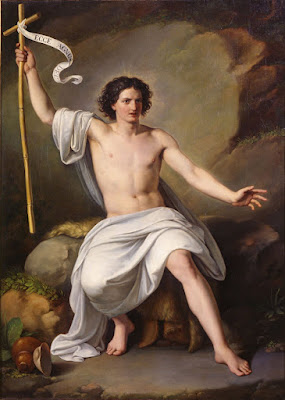-Young-Lady-in-Neglig%C3%A9e-c1769-70-oil-on-canvas-Alte-Nationalgalerie-Staatliche-Museen-zu-Berlin.jpg) |
| Anna Dorothea Lisiewska-Therbusch Young Lady in Negligée ca. 1769-70 oil on canvas Alte Nationalgalerie, Staatliche Museen zu Berlin |
 |
| Élisabeth Vigée Le Brun Portrait of Louise Marie Adélaïde de Bourbon, duchesse d'Orléans ca. 1789 oil on canvas Château de Versailles |
 |
| François Gérard Portrait of Alexandrine-Émilie Brongniart 1795 oil on canvas Yale University Art Gallery |
 |
| Marie-Geneviève Bouliard Portrait of painter Adélaïde Binart 1796 oil on canvas Musée Carnavalet, Paris |
 |
| Eulalie Morin Portrait of Juliette Récamier 1799 oil on canvas Château de Versailles |
 |
| Jacques-Louis David Portrait of Juliette Récamier 1800 oil on canvas Musée du Louvre |
 |
| John Hoppner Portrait of Mrs Dottin ca. 1803-1804 oil on canvas Detroit Institute of Arts |
 |
| Jeanne-Élisabeth Chaudet Girl eating Cherries 1817 oil on canvas Musée Marmottan Monet, Paris |
 |
| Hiram Powers Diana 1852 marble National Gallery of Art, Washington DC |
 |
| Auguste Renoir Lise with a Parasol 1867 oil on canvas Museum Folkwang, Essen |
 |
| Édouard Manet Le Repos ca. 1871 oil on canvas Rhode Island School of Design, Providence |
 |
| Edvard Munch Summer Night - Inger on the Beach 1889 oil on canvas KODE (Art Museums Complex), Bergen, Norway |
 |
| Isidor Kaufmann Hannah ca. 1890 oil on panel Museum of Fine Arts, Boston |
 |
| Antoine Calbet Reader ca. 1890 watercolor and gouache on paper Musée des Beaux-Arts de Reims |
 |
| Isaac Israëls Portrait of Jacqueline Sandberg ca. 1910 oil on canvas Teylers Museum, Haarlem |
-1914-oil-on-canvas-Nasjonalmuseet-Oslo.jpg) |
| Signe Scheel Profile at the Window (Lilli Scheel) 1914 oil on canvas Nasjonalmuseet, Oslo |
Tout cela vous l'avez lu aussi, dans les encadrés de l'antichambre. Vous vous êtes même arrêté devant la reproduction de l'esquisse à l'huile de Géricault qui n'est pas ici au Louvre, qui dort parmi les Girodet dans le musée de Montargis: Corentin en ventôse reçoit l'ordre de peindre les Onze. Le titre donné après coup est approximatif, le tableau est à peine ébauché, il y a de grands pans de blanc, car Géricault l'a peint quand il avait la mort sur l'épaule. Mais il est tout à fait conforme à ce que j'ai dit.
Il ne pouvait en être autrement.
C'est que, Monsieur, l'esquisse de Géricault n'a d'autre valeur que d'avoir inspiré à Monseigneur l'Après-coup en personne, Michelet, Jules Michelet de son nom complet d'état civil, les douze pages définitives qui traitent des Onze, qui mettent en place Les Onze et les dressent devant la tradition historiographique pour les siècles des siècles.
– Pierre Michon, from Les Onze (Verdier, 2009)



-Farmers-drop-a-Crate-1938-hand-colored-lithograph-Smithsonian-American-Art-Museum-Washington-DC.jpg)
-Geometric-Motif-1958-hand-colored-transfer-print-National-Gallery-of-Australia-Canberra.jpg)












-c1400-limestone-statue-Bode-Museum-Berlin.jpg)

-1544-oil-on-panel-Gem%C3%A4ldegalerie-Staatliche-Museen-zu-Berlin.jpg)








-Nasjonalmuseet-Oslo.jpg)

-Arne-1926-oil-on-canvas-Nordonsk-Kunstmuseum-Troms%C3%B8.jpg)





-1993-C-print-Whitney-Museum-of-American-Art-New-York.jpeg)




-Danger-threatens-You-c1925-lithograph-(poster-in-Dutch)-Allard-Pierson-Museum-Amsterdam.jpg)
-Kimberely-Megan-and-Shane-34-Rumler-Road-Linfield-PA-1996-gelatin-silver-print-Amon-Carter-Museum-of-American-Art-Fort-Worth-Texas.jpg)

-c1816-drawing-Graphische-Sammlung-Albertina-Vienna.jpg)

-St%C3%A4del-Museum-Frankfurt.jpg)

-Whitney-Museum-of-American-Art-New-York.jpeg)
-Smithsonian-American-Art-Museum-Washington-DC.jpg)
